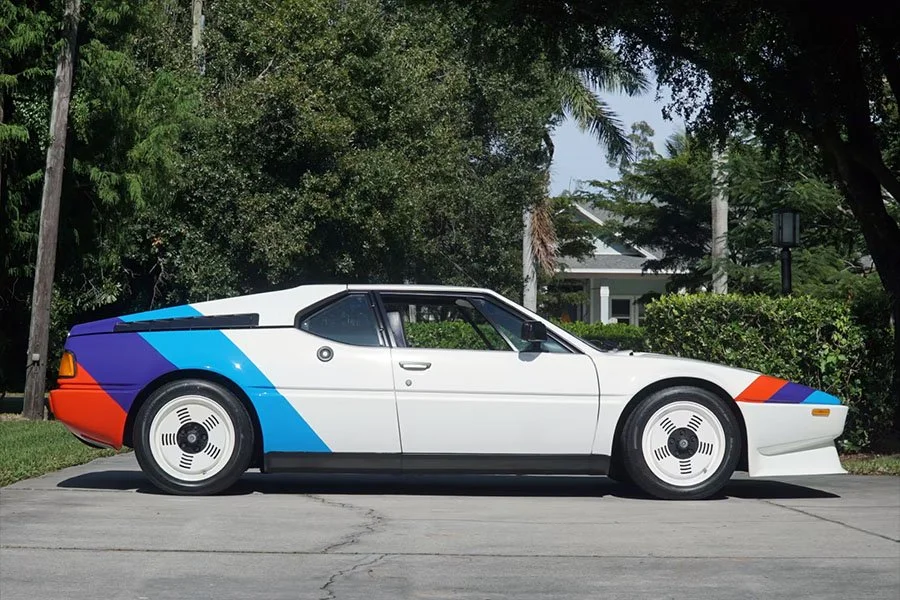Guide: BMW Art Car #4 - BMW M1 Procar 'Andy Warhol'
/BACKGROUND
After three consecutive years of BMW Art Car appearances at the Le Mans 24 Hours (1975, ‘76 and ‘77), a two year gap followed prior to the arrival of a fourth instalment of the theme.
Despite the delay, there was never any doubt that a follow up would be commissioned; the Art Car programme had garnered massive worldwide publicity for BMW and created brand awareness well beyond the traditional automotive sector.
Thanks to an association with arguably the 20th century’s best known artist, this latest creation would become the most famous and perhaps most valuable BMW of all time.
BMW E26 M1 PROCAR
As had been the case for all three previous Art Cars, BMW selected a racing model for project number four: an E26 M1 Procar.
The M1 had been conceived as a homologation special upon which Group 4 and 5 racing cars could take the challenge to Porsche. Unfortunately, having chosen Lamborghini as a development partner, the project became mired in delays owing to chronic mismanagement at the crisis-hit Italian company.
As a consequence, the M1 was not homologated in the anticipated timeframe which meant it was only able to compete at invitational events organised outside of the main World Championship.
To help promote the car, BMW signed a two-year deal for Group 4-spec. M1s to appear in a one-make series that supported most of the European Formula 1 races in 1979 and ‘80. The resultant Procar Championship proved a big hit and went a long way to making up for the lack of acceptance in the Group 4 and 5 categories.
The M1 Procars featured trick alloy instead of iron block 3.5-litre straight six engines which pumped out 470hp – 193bhp up on the production version. The suspension, brakes, steering, wheels and tyres were all uprated, interiors were comprehensively stripped and a dramatic wide-bodied aero kit was installed.
ANDY WARHOL
To paint their M1 Art Car, BMW turned to American artist and film director, Andy Warhol.
Born in Pittsburgh in 1928, Warhol graduated from high school in 1945 and enrolled at the Carnegie Institute of Technology where he studied commercial art until 1949.
Upon completion of his course, Warhol departed for New York City where he began a career in the commercial and advertising art industry. He quickly garnered attention for his innovative styles and techniques which resulted in a first solo show at the Hugo Gallery in New York in 1952.
Later in the decade, Warhol was recruited by RCA Records to design album covers and other promotional materials.
In 1962, Warhol began to adopt a silk screen printmaking process having been taught the technique by Max Arthur Cohen. That year, Warhol also created The Factory, a silver-lined studio on 47th Street where he was helped in the production of silkscreens, films, sculptures and other works by a team of assistants.
Warhol’s subsequent paintings of trivial objects and celebrity portraits catapulted him to international prominence; his work came to be regarded as the quintessence of the Pop Art theme that sought to reverse traditional artistic ideas.
Often controversial and sometime scandalous creations meant that, by the end of the 1960s, Andy Warhol was perhaps the world’s most famous living artist.
WARHOL’S M1 PROCAR
For the BMW M1 commission, Warhol stated: “I tried to portray a sense of speed. When a car is going really fast all the lines and colours become a blur”.
Having first worked on a scale model, Warhol took less than half an hour to paint the full-sized M1. It was covered in the kind of vivid blues, reds, greens and yellows that Warhol commonly used with each irregular section merging into the next.
Warhol said of the famboyant finished article: “I love that car. It has turned out better than the artwork.”
1979 LE MANS 24 HOURS
As had been the case with all three of BMW’s earlier Art Cars, the Andy Warhol M1 was trucked to France where it would contest the Le Mans 24 Hours.
The 1979 event took place over the weekend of June 9th and 10th. The Le Mans governing body, the Automobile Club de l’Ouest, accepted the M1 in their IMSA GTX category.
It appeared under a Herve Poulain entry – Poulain (who would take the wheel along with Marcel Mignot and factory BMW driver, Manfred Winkelhock) had instigated the Art Car programme back in 1975 and raced in both the 1975 and ‘77 runnings.
Impressively, the M1 qualified in 23rd position which was faster than all the 512 BB LM Ferraris and many of the twin turbocharged Porsche 935s.
By midnight the BMW had risen to 14th, soon after which rain began to steadily fall which later became a deluge as a thunderstorm rolled in.
By 6am, the M1 had broken into the top ten and two hours later it had risen to seventh. However, the engine then began running on just five cylinders and at around 9am the car was delayed by 80 minutes to fix a failed clutch which dropped it out of the top ten.
Nevertheless, the drivers continued to press on and, by midday, they were back in tenth. Thereafter, the M1 gained a position every hour to finish a superb sixth overall and second in the over 2.5-litre IMSA category.
Following its one-and-only competition appearance, the Andy Warhol M1 made its way to BMW’s in-house collection where it has resided ever since.
Text copyright: Supercar Nostalgia
Photo copyright: BMW - https://www.bmw.com


































